warning GMC YUKON 2009 Repair Manual
[x] Cancel search | Manufacturer: GMC, Model Year: 2009, Model line: YUKON, Model: GMC YUKON 2009Pages: 576, PDF Size: 3.06 MB
Page 442 of 576
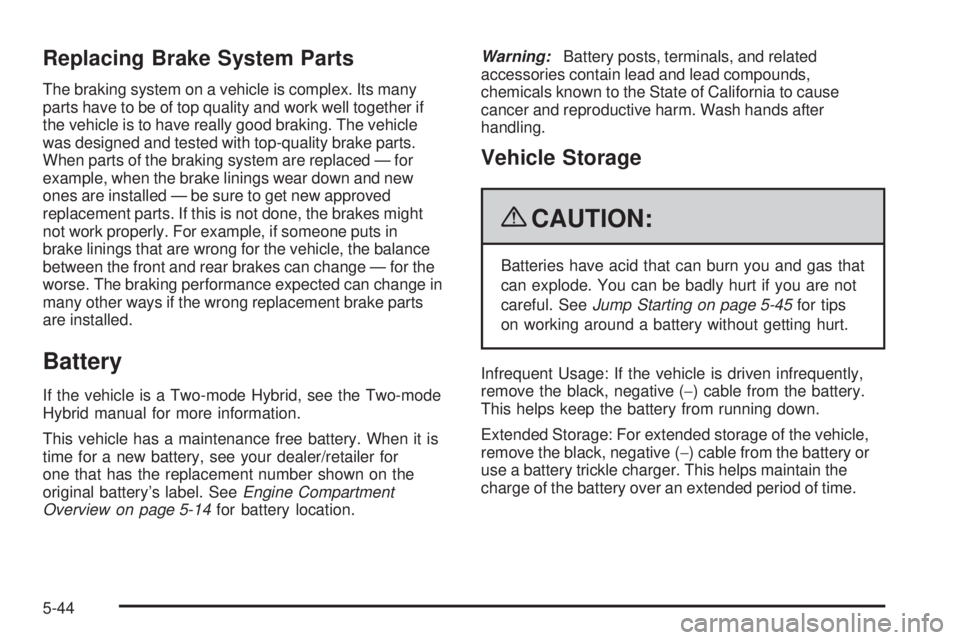
Replacing Brake System Parts
The braking system on a vehicle is complex. Its many
parts have to be of top quality and work well together if
the vehicle is to have really good braking. The vehicle
was designed and tested with top-quality brake parts.
When parts of the braking system are replaced — for
example, when the brake linings wear down and new
ones are installed — be sure to get new approved
replacement parts. If this is not done, the brakes might
not work properly. For example, if someone puts in
brake linings that are wrong for the vehicle, the balance
between the front and rear brakes can change — for the
worse. The braking performance expected can change in
many other ways if the wrong replacement brake parts
are installed.
Battery
If the vehicle is a Two-mode Hybrid, see the Two-mode
Hybrid manual for more information.
This vehicle has a maintenance free battery. When it is
time for a new battery, see your dealer/retailer for
one that has the replacement number shown on the
original battery’s label. SeeEngine Compartment
Overview on page 5-14for battery location.Warning:Battery posts, terminals, and related
accessories contain lead and lead compounds,
chemicals known to the State of California to cause
cancer and reproductive harm. Wash hands after
handling.
Vehicle Storage
{CAUTION:
Batteries have acid that can burn you and gas that
can explode. You can be badly hurt if you are not
careful. SeeJump Starting on page 5-45for tips
on working around a battery without getting hurt.
Infrequent Usage: If the vehicle is driven infrequently,
remove the black, negative (−) cable from the battery.
This helps keep the battery from running down.
Extended Storage: For extended storage of the vehicle,
remove the black, negative (−) cable from the battery or
use a battery trickle charger. This helps maintain the
charge of the battery over an extended period of time.
5-44
Page 472 of 576
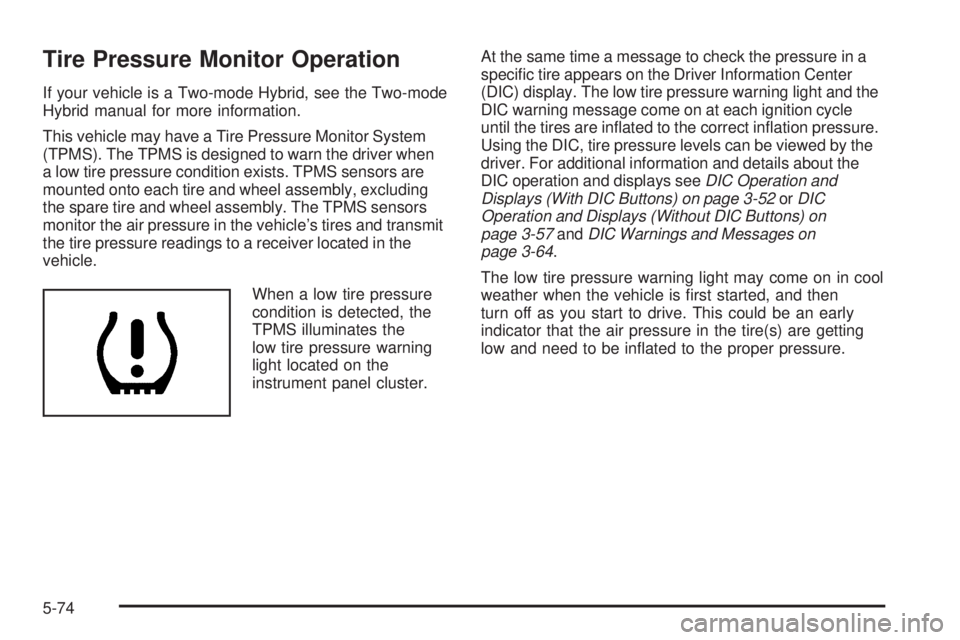
Tire Pressure Monitor Operation
If your vehicle is a Two-mode Hybrid, see the Two-mode
Hybrid manual for more information.
This vehicle may have a Tire Pressure Monitor System
(TPMS). The TPMS is designed to warn the driver when
a low tire pressure condition exists. TPMS sensors are
mounted onto each tire and wheel assembly, excluding
the spare tire and wheel assembly. The TPMS sensors
monitor the air pressure in the vehicle’s tires and transmit
the tire pressure readings to a receiver located in the
vehicle.
When a low tire pressure
condition is detected, the
TPMS illuminates the
low tire pressure warning
light located on the
instrument panel cluster.At the same time a message to check the pressure in a
speci�c tire appears on the Driver Information Center
(DIC) display. The low tire pressure warning light and the
DIC warning message come on at each ignition cycle
until the tires are in�ated to the correct in�ation pressure.
Using the DIC, tire pressure levels can be viewed by the
driver. For additional information and details about the
DIC operation and displays seeDIC Operation and
Displays (With DIC Buttons) on page 3-52orDIC
Operation and Displays (Without DIC Buttons) on
page 3-57andDIC Warnings and Messages on
page 3-64.
The low tire pressure warning light may come on in cool
weather when the vehicle is �rst started, and then
turn off as you start to drive. This could be an early
indicator that the air pressure in the tire(s) are getting
low and need to be in�ated to the proper pressure.
5-74
Page 473 of 576
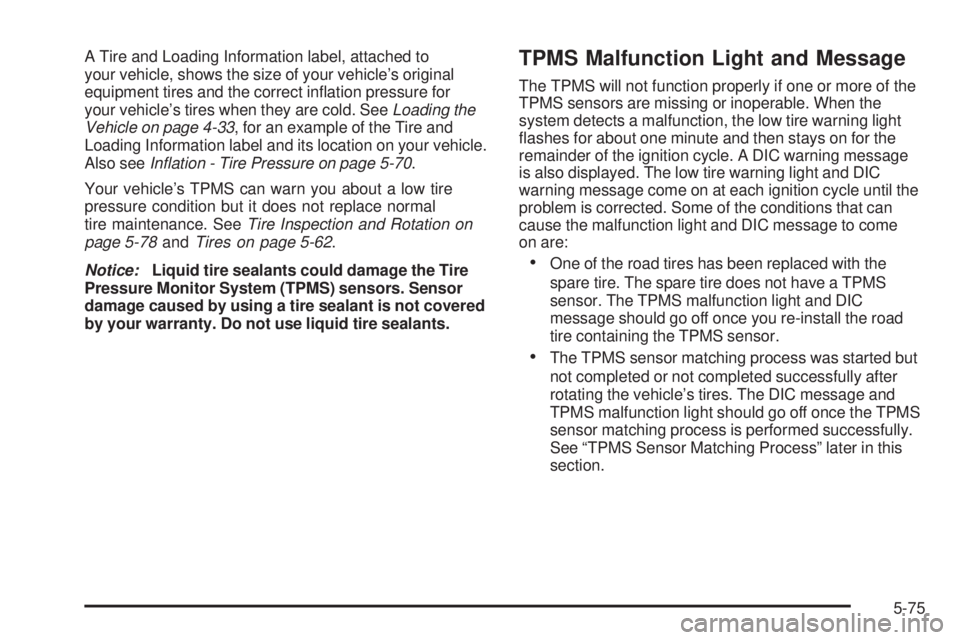
A Tire and Loading Information label, attached to
your vehicle, shows the size of your vehicle’s original
equipment tires and the correct in�ation pressure for
your vehicle’s tires when they are cold. SeeLoading the
Vehicle on page 4-33, for an example of the Tire and
Loading Information label and its location on your vehicle.
Also seeInflation - Tire Pressure on page 5-70.
Your vehicle’s TPMS can warn you about a low tire
pressure condition but it does not replace normal
tire maintenance. SeeTire Inspection and Rotation on
page 5-78andTires on page 5-62.
Notice:Liquid tire sealants could damage the Tire
Pressure Monitor System (TPMS) sensors. Sensor
damage caused by using a tire sealant is not covered
by your warranty. Do not use liquid tire sealants.TPMS Malfunction Light and Message
The TPMS will not function properly if one or more of the
TPMS sensors are missing or inoperable. When the
system detects a malfunction, the low tire warning light
�ashes for about one minute and then stays on for the
remainder of the ignition cycle. A DIC warning message
is also displayed. The low tire warning light and DIC
warning message come on at each ignition cycle until the
problem is corrected. Some of the conditions that can
cause the malfunction light and DIC message to come
on are:
One of the road tires has been replaced with the
spare tire. The spare tire does not have a TPMS
sensor. The TPMS malfunction light and DIC
message should go off once you re-install the road
tire containing the TPMS sensor.
The TPMS sensor matching process was started but
not completed or not completed successfully after
rotating the vehicle’s tires. The DIC message and
TPMS malfunction light should go off once the TPMS
sensor matching process is performed successfully.
See “TPMS Sensor Matching Process” later in this
section.
5-75
Page 479 of 576
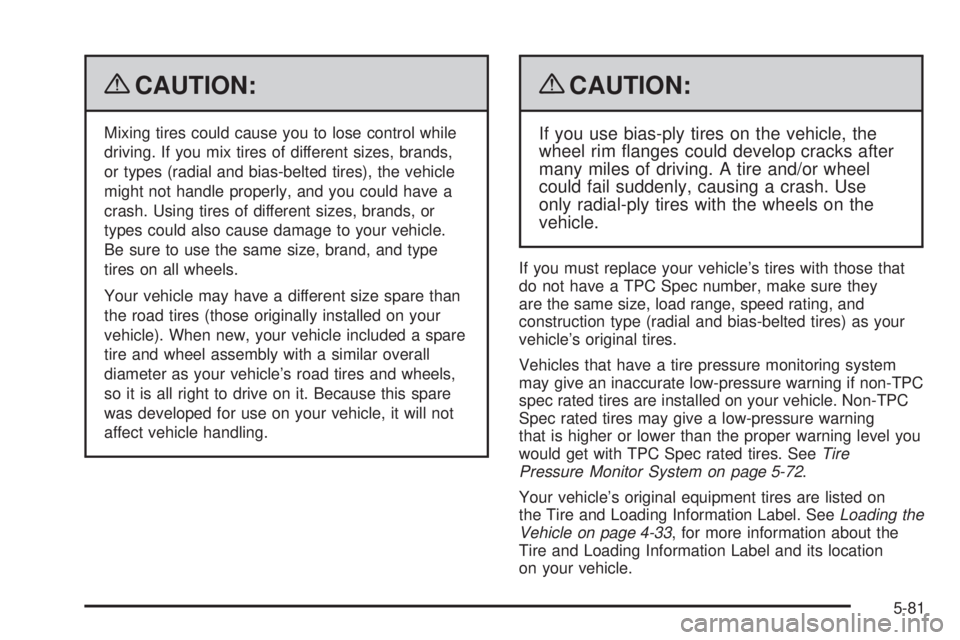
{CAUTION:
Mixing tires could cause you to lose control while
driving. If you mix tires of different sizes, brands,
or types (radial and bias-belted tires), the vehicle
might not handle properly, and you could have a
crash. Using tires of different sizes, brands, or
types could also cause damage to your vehicle.
Be sure to use the same size, brand, and type
tires on all wheels.
Your vehicle may have a different size spare than
the road tires (those originally installed on your
vehicle). When new, your vehicle included a spare
tire and wheel assembly with a similar overall
diameter as your vehicle’s road tires and wheels,
so it is all right to drive on it. Because this spare
was developed for use on your vehicle, it will not
affect vehicle handling.
{CAUTION:
If you use bias-ply tires on the vehicle, the
wheel rim �anges could develop cracks after
many miles of driving. A tire and/or wheel
could fail suddenly, causing a crash. Use
only radial-ply tires with the wheels on the
vehicle.
If you must replace your vehicle’s tires with those that
do not have a TPC Spec number, make sure they
are the same size, load range, speed rating, and
construction type (radial and bias-belted tires) as your
vehicle’s original tires.
Vehicles that have a tire pressure monitoring system
may give an inaccurate low-pressure warning if non-TPC
spec rated tires are installed on your vehicle. Non-TPC
Spec rated tires may give a low-pressure warning
that is higher or lower than the proper warning level you
would get with TPC Spec rated tires. SeeTire
Pressure Monitor System on page 5-72.
Your vehicle’s original equipment tires are listed on
the Tire and Loading Information Label. SeeLoading the
Vehicle on page 4-33, for more information about the
Tire and Loading Information Label and its location
on your vehicle.
5-81
Page 481 of 576
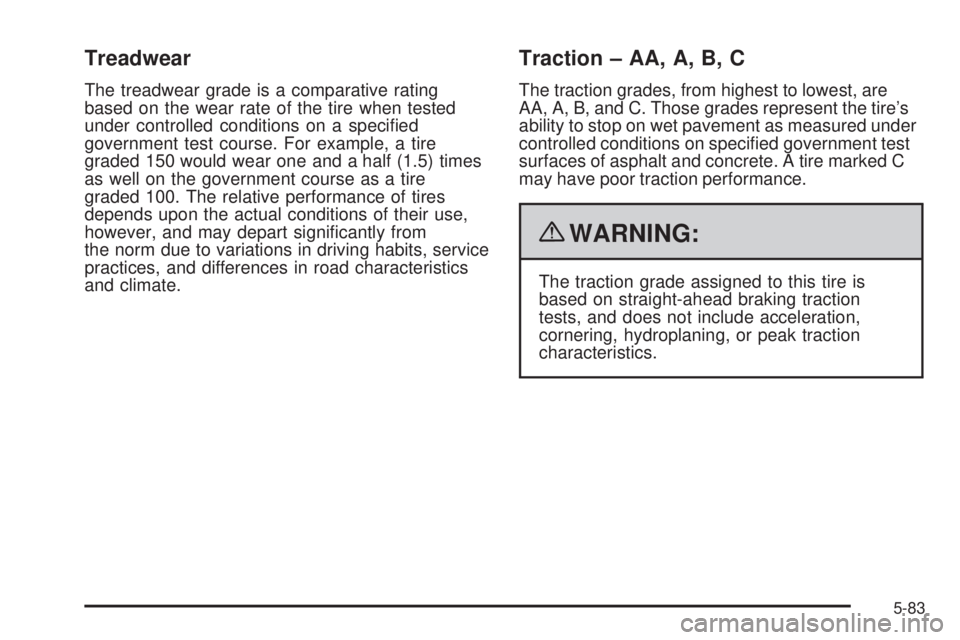
Treadwear
The treadwear grade is a comparative rating
based on the wear rate of the tire when tested
under controlled conditions on a speci�ed
government test course. For example, a tire
graded 150 would wear one and a half (1.5) times
as well on the government course as a tire
graded 100. The relative performance of tires
depends upon the actual conditions of their use,
however, and may depart signi�cantly from
the norm due to variations in driving habits, service
practices, and differences in road characteristics
and climate.
Traction – AA, A, B, C
The traction grades, from highest to lowest, are
AA, A, B, and C. Those grades represent the tire’s
ability to stop on wet pavement as measured under
controlled conditions on speci�ed government test
surfaces of asphalt and concrete. A tire marked C
may have poor traction performance.
{WARNING:
The traction grade assigned to this tire is
based on straight-ahead braking traction
tests, and does not include acceleration,
cornering, hydroplaning, or peak traction
characteristics.
5-83
Page 482 of 576
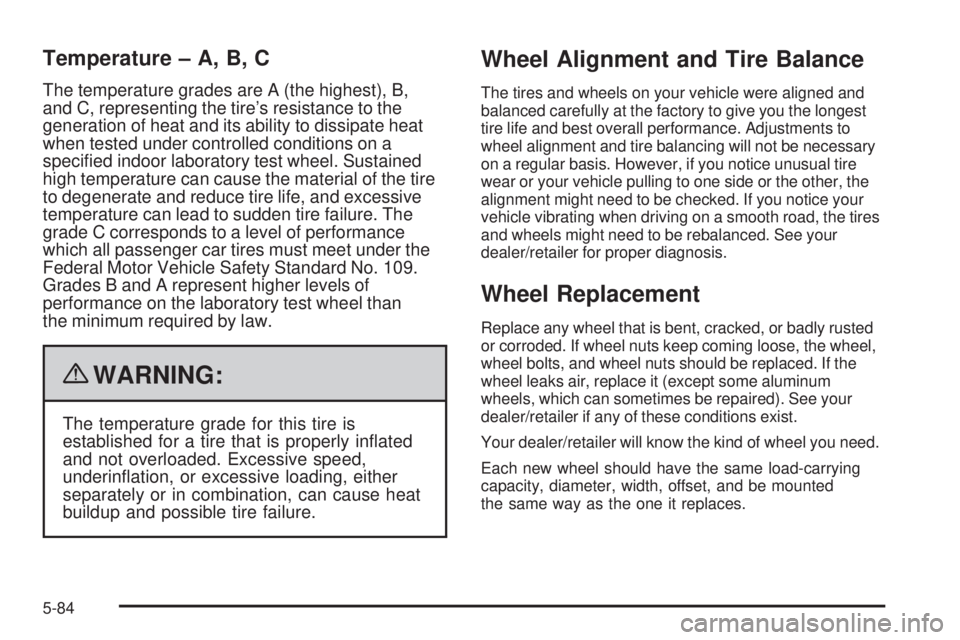
Temperature – A, B, C
The temperature grades are A (the highest), B,
and C, representing the tire’s resistance to the
generation of heat and its ability to dissipate heat
when tested under controlled conditions on a
speci�ed indoor laboratory test wheel. Sustained
high temperature can cause the material of the tire
to degenerate and reduce tire life, and excessive
temperature can lead to sudden tire failure. The
grade C corresponds to a level of performance
which all passenger car tires must meet under the
Federal Motor Vehicle Safety Standard No. 109.
Grades B and A represent higher levels of
performance on the laboratory test wheel than
the minimum required by law.
{WARNING:
The temperature grade for this tire is
established for a tire that is properly in�ated
and not overloaded. Excessive speed,
underin�ation, or excessive loading, either
separately or in combination, can cause heat
buildup and possible tire failure.
Wheel Alignment and Tire Balance
The tires and wheels on your vehicle were aligned and
balanced carefully at the factory to give you the longest
tire life and best overall performance. Adjustments to
wheel alignment and tire balancing will not be necessary
on a regular basis. However, if you notice unusual tire
wear or your vehicle pulling to one side or the other, the
alignment might need to be checked. If you notice your
vehicle vibrating when driving on a smooth road, the tires
and wheels might need to be rebalanced. See your
dealer/retailer for proper diagnosis.
Wheel Replacement
Replace any wheel that is bent, cracked, or badly rusted
or corroded. If wheel nuts keep coming loose, the wheel,
wheel bolts, and wheel nuts should be replaced. If the
wheel leaks air, replace it (except some aluminum
wheels, which can sometimes be repaired). See your
dealer/retailer if any of these conditions exist.
Your dealer/retailer will know the kind of wheel you need.
Each new wheel should have the same load-carrying
capacity, diameter, width, offset, and be mounted
the same way as the one it replaces.
5-84
Page 486 of 576
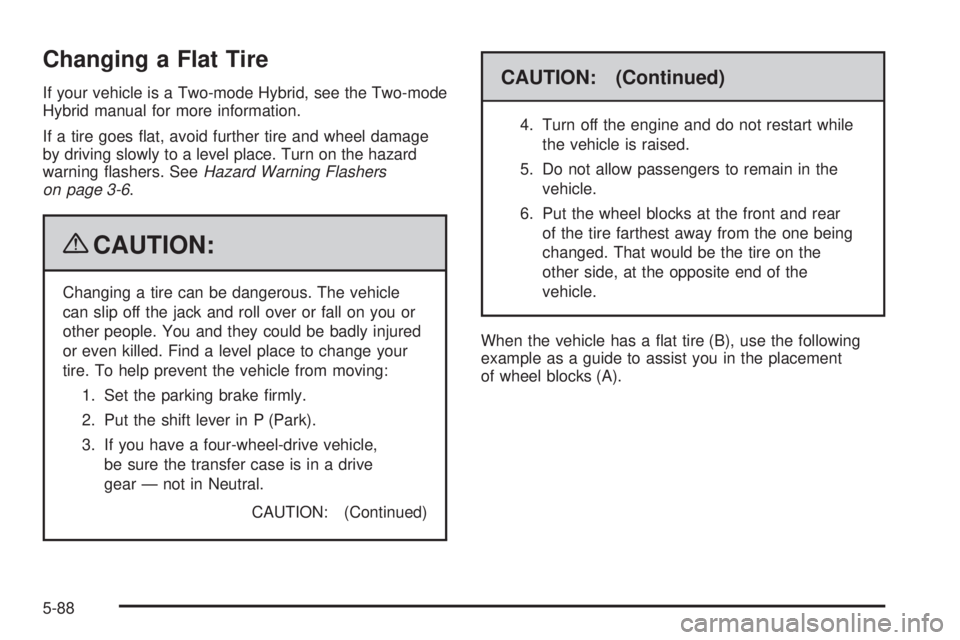
Changing a Flat Tire
If your vehicle is a Two-mode Hybrid, see the Two-mode
Hybrid manual for more information.
If a tire goes �at, avoid further tire and wheel damage
by driving slowly to a level place. Turn on the hazard
warning �ashers. SeeHazard Warning Flashers
on page 3-6.
{CAUTION:
Changing a tire can be dangerous. The vehicle
can slip off the jack and roll over or fall on you or
other people. You and they could be badly injured
or even killed. Find a level place to change your
tire. To help prevent the vehicle from moving:
1. Set the parking brake �rmly.
2. Put the shift lever in P (Park).
3. If you have a four-wheel-drive vehicle,
be sure the transfer case is in a drive
gear — not in Neutral.
CAUTION: (Continued)
CAUTION: (Continued)
4. Turn off the engine and do not restart while
the vehicle is raised.
5. Do not allow passengers to remain in the
vehicle.
6. Put the wheel blocks at the front and rear
of the tire farthest away from the one being
changed. That would be the tire on the
other side, at the opposite end of the
vehicle.
When the vehicle has a �at tire (B), use the following
example as a guide to assist you in the placement
of wheel blocks (A).
5-88
Page 563 of 576
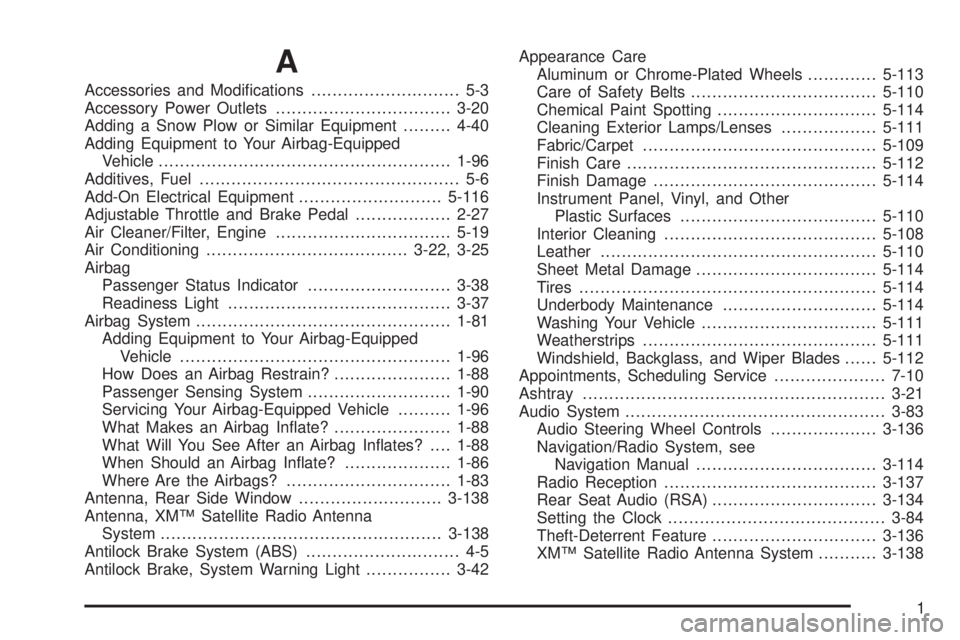
A
Accessories and Modi�cations............................ 5-3
Accessory Power Outlets.................................3-20
Adding a Snow Plow or Similar Equipment.........4-40
Adding Equipment to Your Airbag-Equipped
Vehicle.......................................................1-96
Additives, Fuel................................................. 5-6
Add-On Electrical Equipment...........................5-116
Adjustable Throttle and Brake Pedal..................2-27
Air Cleaner/Filter, Engine.................................5-19
Air Conditioning......................................3-22, 3-25
Airbag
Passenger Status Indicator...........................3-38
Readiness Light..........................................3-37
Airbag System................................................1-81
Adding Equipment to Your Airbag-Equipped
Vehicle...................................................1-96
How Does an Airbag Restrain?......................1-88
Passenger Sensing System...........................1-90
Servicing Your Airbag-Equipped Vehicle..........1-96
What Makes an Airbag In�ate?......................1-88
What Will You See After an Airbag In�ates?....1-88
When Should an Airbag In�ate?....................1-86
Where Are the Airbags?...............................1-83
Antenna, Rear Side Window...........................3-138
Antenna, XM™ Satellite Radio Antenna
System.....................................................3-138
Antilock Brake System (ABS)............................. 4-5
Antilock Brake, System Warning Light................3-42Appearance Care
Aluminum or Chrome-Plated Wheels.............5-113
Care of Safety Belts...................................5-110
Chemical Paint Spotting..............................5-114
Cleaning Exterior Lamps/Lenses..................5-111
Fabric/Carpet............................................5-109
Finish Care...............................................5-112
Finish Damage..........................................5-114
Instrument Panel, Vinyl, and Other
Plastic Surfaces.....................................5-110
Interior Cleaning........................................
5-108
Leather....................................................5-110
Sheet Metal Damage..................................5-114
Tires........................................................5-114
Underbody Maintenance.............................5-114
Washing Your Vehicle.................................5-111
Weatherstrips............................................5-111
Windshield, Backglass, and Wiper Blades......5-112
Appointments, Scheduling Service.....................7-10
Ashtray.........................................................3-21
Audio System.................................................3-83
Audio Steering Wheel Controls....................3-136
Navigation/Radio System, see
Navigation Manual..................................3-114
Radio Reception........................................3-137
Rear Seat Audio (RSA)...............................3-134
Setting the Clock.........................................3-84
Theft-Deterrent Feature...............................3-136
XM™ Satellite Radio Antenna System...........3-138
1
Page 564 of 576
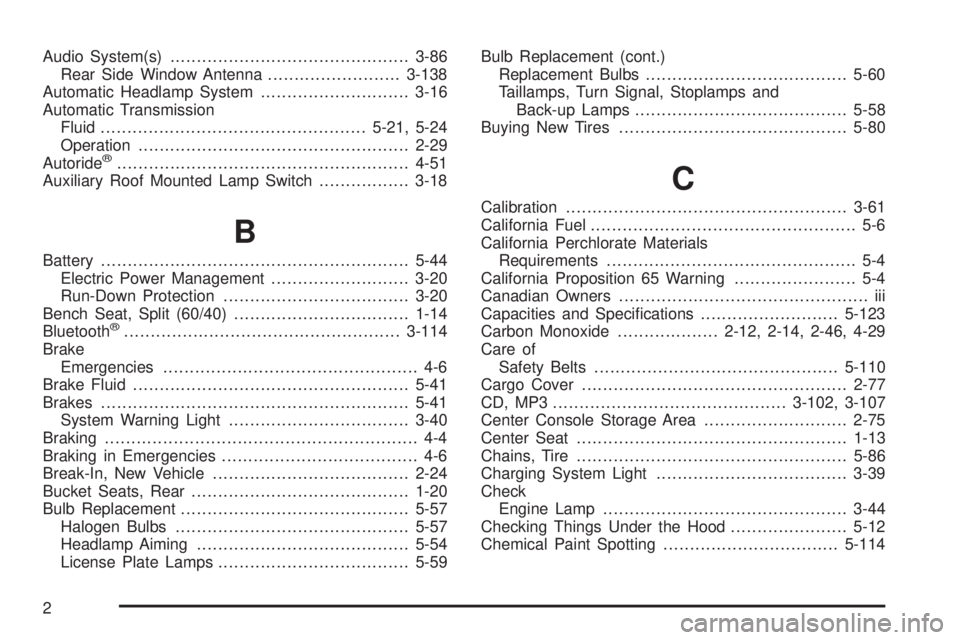
Audio System(s).............................................3-86
Rear Side Window Antenna.........................3-138
Automatic Headlamp System............................3-16
Automatic Transmission
Fluid..................................................5-21, 5-24
Operation...................................................2-29
Autoride
®.......................................................4-51
Auxiliary Roof Mounted Lamp Switch.................3-18
B
Battery..........................................................5-44
Electric Power Management..........................3-20
Run-Down Protection...................................3-20
Bench Seat, Split (60/40).................................1-14
Bluetooth
®....................................................3-114
Brake
Emergencies................................................ 4-6
Brake Fluid....................................................5-41
Brakes..........................................................5-41
System Warning Light..................................3-40
Braking........................................................... 4-4
Braking in Emergencies..................................... 4-6
Break-In, New Vehicle.....................................2-24
Bucket Seats, Rear.........................................1-20
Bulb Replacement...........................................5-57
Halogen Bulbs............................................5-57
Headlamp Aiming........................................5-54
License Plate Lamps....................................5-59Bulb Replacement (cont.)
Replacement Bulbs......................................5-60
Taillamps, Turn Signal, Stoplamps and
Back-up Lamps........................................5-58
Buying New Tires...........................................5-80
C
Calibration.....................................................3-61
California Fuel.................................................. 5-6
California Perchlorate Materials
Requirements............................................... 5-4
California Proposition 65 Warning....................... 5-4
Canadian Owners............................................... iii
Capacities and Speci�cations..........................5-123
Carbon Monoxide...................2-12, 2-14, 2-46, 4-29
Care of
Safety Belts..............................................5-110
Cargo Cover..................................................2-77
CD, MP3 ............................................3-102, 3-107
Center Console Storage Area...........................2-75
Center Seat...................................................1-13
Chains, Tire...................................................5-86
Charging System Light....................................3-39
Check
Engine Lamp..............................................3-44
Checking Things Under the Hood......................5-12
Chemical Paint Spotting.................................5-114
2
Page 566 of 576
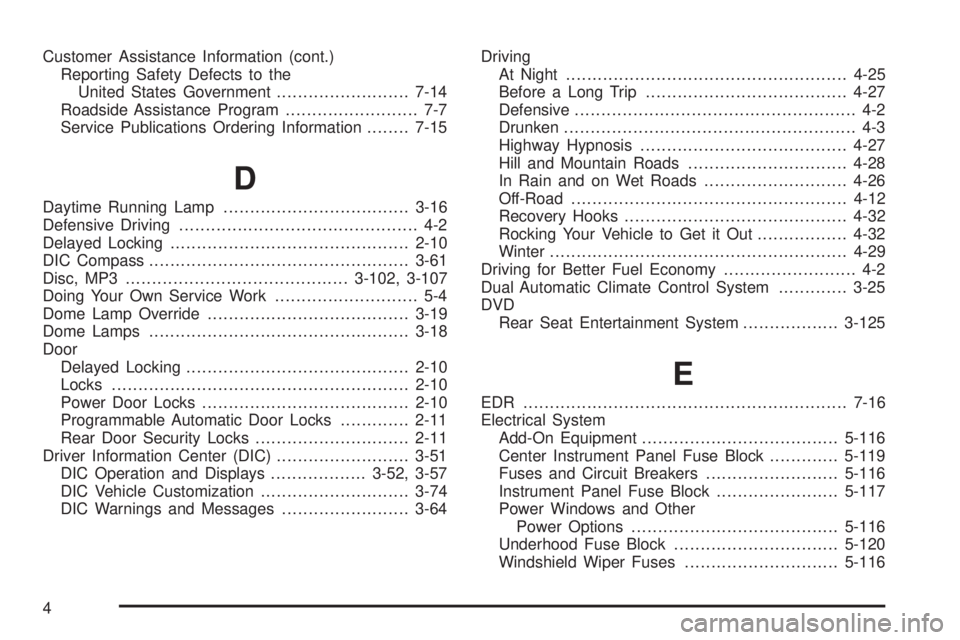
Customer Assistance Information (cont.)
Reporting Safety Defects to the
United States Government.........................7-14
Roadside Assistance Program......................... 7-7
Service Publications Ordering Information........7-15
D
Daytime Running Lamp...................................3-16
Defensive Driving............................................. 4-2
Delayed Locking.............................................2-10
DIC Compass.................................................3-61
Disc, MP3..........................................3-102, 3-107
Doing Your Own Service Work........................... 5-4
Dome Lamp Override......................................3-19
Dome Lamps .................................................3-18
Door
Delayed Locking..........................................2-10
Locks........................................................2-10
Power Door Locks.......................................2-10
Programmable Automatic Door Locks.............2-11
Rear Door Security Locks.............................2-11
Driver Information Center (DIC).........................3-51
DIC Operation and Displays..................3-52, 3-57
DIC Vehicle Customization............................3-74
DIC Warnings and Messages........................3-64Driving
At Night.....................................................4-25
Before a Long Trip......................................4-27
Defensive..................................................... 4-2
Drunken....................................................... 4-3
Highway Hypnosis.......................................4-27
Hill and Mountain Roads..............................4-28
In Rain and on Wet Roads...........................4-26
Off-Road ....................................................4-12
Recovery Hooks..........................................4-32
Rocking Your Vehicle to Get it Out.................4-32
Winter........................................................4-29
Driving for Better Fuel Economy......................... 4-2
Dual Automatic Climate Control System.............3-25
DVD
Rear Seat Entertainment System..................3-125
E
EDR .............................................................7-16
Electrical System
Add-On Equipment.....................................5-116
Center Instrument Panel Fuse Block.............5-119
Fuses and Circuit Breakers.........................5-116
Instrument Panel Fuse Block.......................5-117
Power Windows and Other
Power Options.......................................5-116
Underhood Fuse Block...............................5-120
Windshield Wiper Fuses.............................5-116
4